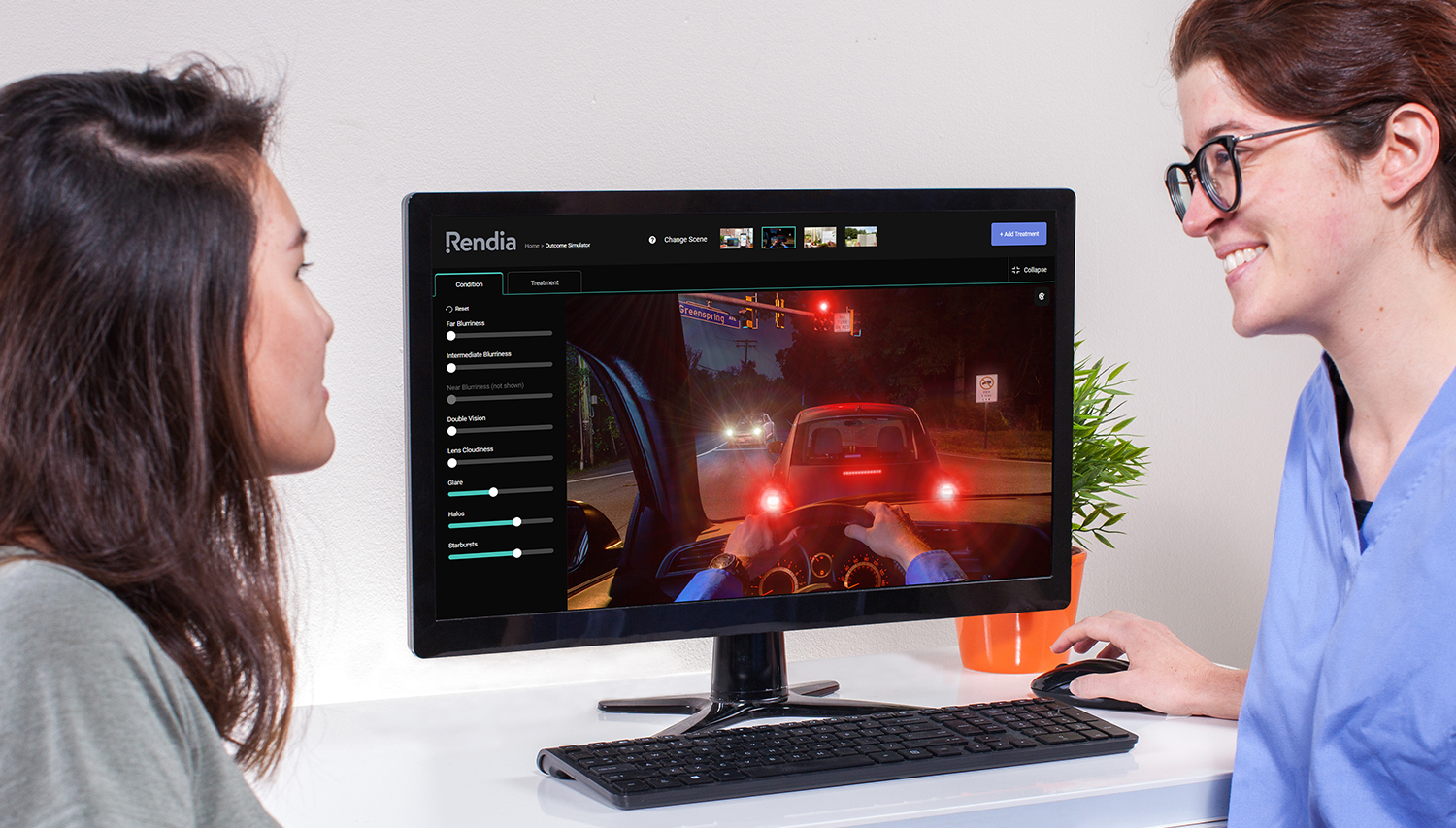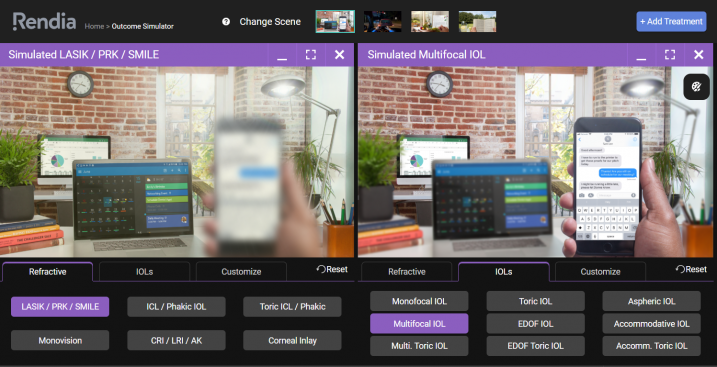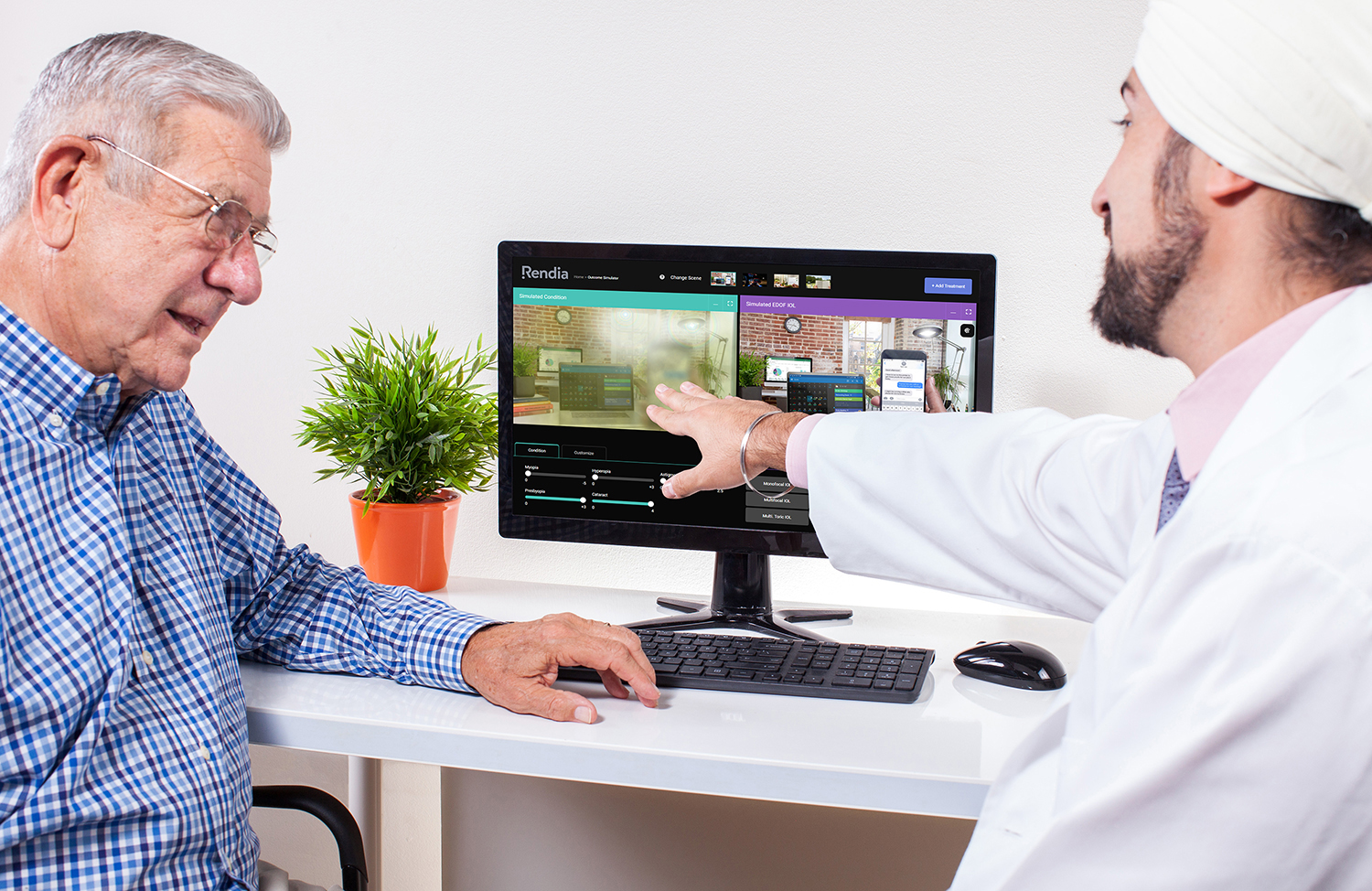Increase premium conversions, boost patients’ confidence in their treatment decisions, and avoid buyer’s remorse
What is the Outcome Simulator?
Rendia’s Outcome Simulator was born out of conversations with our customers who explained their challenges communicating the value of premium IOLs or the side effects of refractive surgery to their patients. While existing simulators of cataract or refractive surgery outcomes showed basic comparisons, some of the deficiencies we heard about were that these simulators took a long time to load, the scenes were not very realistic or relatable, and the simulations themselves were fixed and oversimplified.
As a result, the Outcome Simulator has been carefully designed with doctors and counselors in mind, making it the most advanced vision simulator. The tool is:
- Customizable to each patient. You can demonstrate their current visual acuity with different degrees of severity, so that patients can get the whole picture of their vision, before and after treatment. Plus, settings aren’t fixed — you can adjust the near blurriness on a treatment, for example, putting you in complete control of the simulation.
- Relatable. We did custom photo shoots for the simulator to capture realistic scenarios, so that patients could easily imagine situations in their own lives affected by blurry vision. The tool’s high-quality images support your brand’s image as a high-tech practice.
- Fast and intuitive by design. The Outcome Simulator loads and responds quickly. We’ve extensively tested the product with customers to ensure that sliders and buttons are easy to find and understand so that you can make comparisons in an instant.
With the Outcome Simulator, show—don’t just tell— how you can improve patients’ vision. Give patients the confidence to make an informed treatment decision AND manage their expectations so that they don’t make erroneous (and preventable) assumptions. By getting on the same page with patients, you lay the foundation for better outcomes, which boosts your reputation as a world-class surgeon.
With the Outcome Simulator, show—don’t just tell— how you can improve patients’ vision.
Increase Premium Conversions
You want patients to experience outcomes that exceed their expectations and improve their quality of life. To do so, patients need to understand the value of treatment options or elective add-ons before opting in. Therefore, you need to effectively explain how options will enhance their lifestyle in a way that resonates.
The Outcome Simulator lets you quickly compare treatment options for any simulated condition. Let’s say you have a cataract patient who has indicated in her lifestyle questionnaire that she’s always losing her reading glasses and enjoys writing book reviews on her computer. She’s a strong premium IOL candidate, except that she enters your practice intending to only get what’s covered by Medicare.
Using the Outcome Simulator, you choose the office scene and show the patient what her computer could look like with the monofocal IOL compared to the extended-depth-of focus IOL. As you toggle between the two options, the superior intermediate and near vision with the EDOF is obvious. Your patient suddenly starts doubting her initial plans to go for the standard IOL as she sees the impact the EDOF could have on her daily life: less dependence on glasses to do her computer work and read small text. Plus, if she has a spouse or family member with her in the visit, you can use the visual simulations to help them empathize with the patient’s vision problems and get their buy-in as well.
When someone comes into your practice expecting to spend nothing (or very little) money out-of-pocket, the onus is on you and your staff to help the patient weigh the costs of each treatment option and make an informed decision. By using relatable, realistic imagery, and personalizing the simulation to their prescription, the Outcome Simulator is a fast and easy way to help patients understand the value of each option.
Manage Risk and Boost Reputation
On the other hand, enthusiastic patients who are eager to undergo a procedure may present a hidden threat — overly optimistic expectations. If not properly counseled, these patients may set you up for failure: bad reviews, or worse, threatened legal action. If cataract patients have self-educated on IOL manufacturer websites and come in expecting you to restore the perfect vision they had at age 20, they are likely to be disappointed by the performance of any IOL. If LASIK patients don’t understand the risk of halos and glare post-surgery, they may end up with the dreaded buyer’s remorse, a practice’s worst nightmare.
How do you make sure your patients truly understand what they’re signing up for? Use the Outcome Simulator’s night driving scene to walk patients through visual disturbances such as glare, halos, starbursts and blur at varying distances. One of Rendia’s customers even tries to undersell customers on treatments by showing them the worst-case scenarios. The result? His patients are pleasantly surprised with their outcomes, and are so thrilled that they don’t have the significant visual disturbances he simulates, they go on to recommend him to their friends and family.

Making interactive visuals part of a comprehensive informed consent process will manage expectations and get you and your patients on the same page. For example, do your patients believe that LASIK “wears off”? Don’t wait until they develop presbyopia and then tell their friends or worse, write you a bad review, saying that the LASIK didn’t last. Instead, use the surgery consultation as an opportunity to help patients understand and anticipate future changes to their vision, such as presbyopia and cataract. Doing so addresses misconceptions up front, laying the foundation of a relationship for lifelong eye health.
Use the Outcome Simulator to show what LASIK does and does not treat. Illustrate the different refractive errors (and feel free to jump to Exam Mode for a quick anatomy reference), and explain how presbyopia is likely to occur. Additionally, if you have a LASIK consult for a patient who is over 40, you can also use the simulator to introduce elective lens replacement as another option.

Better Expectations, Better Outcomes
The Outcome Simulator was designed to help surgeons, surgical counselors, and co-managing optometrists with all types of patients. If you’re with a Type A patient who needs to understand exactly what they can expect from various treatments, simulating outcomes will help them get to the “aha” moment faster. If you have indecisive patients calling your staff with what Dr. Steven Dell calls, “the information-seeking spiral,” simulate their options in a relatable scenario. If you have patients who are hesitant about the out-of-pocket costs of a procedure, you can articulate the value and help them make an informed choice. A good explanation can establish trust and confidence between patient and provider.
When patients have a better understanding of their options, they feel more involved in their care decisions and invested in the outcome. By adding quick vision simulations to your consult process, you’ll ease patients’ anxieties and maximize your conversions, which in turn helps your practice run more efficiently and profitably.
Ready to give Outcome Simulator a try?
Already a Rendia Customer?
Log into rendia.com and click Outcome Simulator on the left sidebar. Use the sliders to simulate conditions on the left and click the buttons to simulate treatment options on the right.
Not yet a Rendia Customer?
No problem! We’d love to show you how it works first-hand. Schedule a quick demonstration today.

